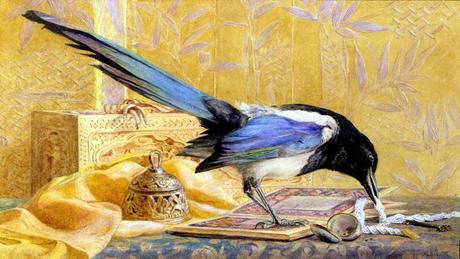Today's post is by way of gathering some research in one place to help others. The subject of this post is Clementina Margaret Hull, a now-forgotten watercolourist, but while researching her, I have found some interesting things about her and her family. It all started when Mr Walker showed me a painting and I asked 'And what do we know about the painter?' Flap all, apparently...

The Thief (c.1860-70) Clementina Margaret Hull
I'll come to the subject of this rather smashing watercolour in a moment but first of all, here is the story of Miss Clementina Margaret Hull and her family.Dr George Montgomery Hull (1794-1878) had been born in Ayrshire before training in medicine and surgery at Edinburgh. He was a member of the Royal College of Surgeons and Royal College of Physicians in Edinburgh but headed south, possibly looking to specialise in diseases of the wealthy. He met the lovely Susanna, fifteen years his junior, and they married around 1840. The life of a young doctor involved a bit of traveling around, as their first children, twins Agnes and Susanna (named for her mother) were born in the outskirts of London in the early months of 1843. Clementina was born a year later, followed by Mary Ann (1845), George (1847) (all born in Surrey) Caroline (1849) (Norfolk) and William (1851). By this time the family had been living in Tonbridge Wells in Kent but the medical practice was doing so well that George moved his family to Kensington, to 1 St Mary Abbot's Terrace, a stone's throw away from Lord Leighton's House (or what would be). Just the sort of place to find lots of ill rich people...
The success of Dr George Hull was probably what inspired his son and namesake George junior to become a doctor. Mind you Dr George jnr did not exactly have a long and happy life. He married Isabel Ogle (splendid name), the daughter of John Connell Ogle, an artist from Essex. Isabel and George jnr moved to South Africa, where they married in 1875. Tragically, in 1878, the following report appeared in the newspapers back home - '12th August,thrown from his horse and killed in Queenstown, South Africa, George Askew Hull MRCS, son of George Hull MD 89 Holland Rd, Kensington'. He might be dead but rest assured his father has a house in Kensington, so that's okay.
Back to Clementina, and she decided that the artist's life was the one for her. In the 1861 census both she and her older sister Susanna were attending art school, and she got an honourable mention in the press reports of the Dudley Gallery exhibition in 1866. In 1872, the London Daily News mentioned that Clementina had received an award at the South Kensington School of Art prize-giving for her paintings of flowers and watercolours from nature. We don't seem to have a date for The Thief above but it is an obvious display of her talent for painting from nature, as that is a rather lovely magpie.
Susanna, however, did not follow her sister into the artistic profession after her training. Her twin Agnes became a teacher of literature and music, teaching in St Aubyn's School in Weymouth before marrying a train engineer and settling in Hampshire. Susanna possibly was inspired by her twin to get into teaching but it was the education of deaf children that interested her. In 1880, she was one of the British representatives at the Second International Congress on Education of the Deaf in Milan. Susanna opened her own school for deaf children at the family home in St Mary's Abbott Terrace in Kensington, moving to Warwick Gardens in 1869. Clementina continued to live with her sister and so I wonder if she taught art at her sister's schools. By 1901, Clementina was living on her own but in the census she is listed merely as 'living on her own means' so it is possible that her ambitions as an artist had ceased. She died in a nursing home in Guildford in 1911, aged 66.
So, what is The Thief all about? The painting comes with a subtitle - 'Then it chanced in a nobleman's palace, that a necklace of pearls was lost.' These words are from Henry Wadsworth Longfellow's poem Evangeline: A Tale of Arcadie which tells the story of two lovers who are separated only to find each other at the end of the man's life. What's all that to do with a jewellery-obsessed magpie? Well, actually the bird appears in a story told by a notary in the poem proving how God is just even if men are not. What Clementina Hull painted is actually the scene that we do not witness in the poem. As the subtitle says, in a nobleman's palace a necklace went missing. The maid was blamed and hanged for the crime in the shadow of a giant, ironic statue of Justice. After her death, God struck the statue with lightening and there in the ruins was a magpie nest with the necklace in it. As Clementina was a painter of nature rather of literary subjects I wonder if she just fancied painting a magpie and found a fancy quote to go with it. Whatever the reason, I would love to know more of the mysterious Miss Hull and see more of her work...

